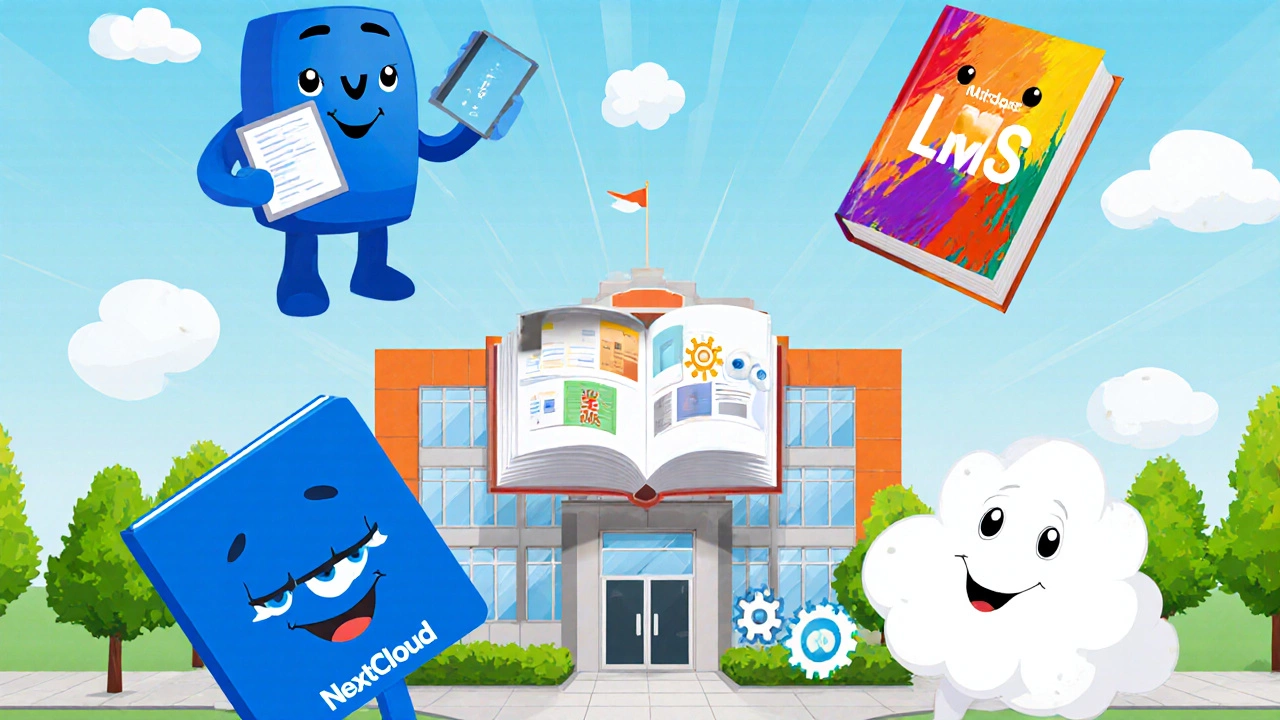School Platform Cost Calculator
Compare Your School's Platform Costs
Calculate annual costs for different education platforms based on your student population and staff numbers.
When a school decides to move away from Google Workspace for Education - the bundle that includes Gmail, Drive, Docs, and Classroom - it’s usually a sign of deeper worries about privacy, cost, and control. In the past few years, districts across the US, Europe, and Oceania have started questioning whether a single vendor should hold so much of their data and daily workflows. If you’re an admin, teacher, or parent wondering why this shift is happening, read on. You’ll get the real reasons, a side‑by‑side look at the biggest alternatives, and a step‑by‑step migration checklist.
What’s Triggering the Move?
Three forces are converging:
- Data‑privacy backlash. Laws like FERPA in the US, GDPR in the EU, and the Australian Privacy Act are tightening how student information can be stored and shared. Schools worry that Google’s default cloud locations may not meet local residency rules.
- Rising subscription costs. As Google adds AI‑powered features, annual per‑user fees have climbed 12‑15% year over year. For a district with 5,000 students, that adds up to six‑figure budgets that could be spent elsewhere.
- Vendor lock‑in. The deeper a school integrates with Google Docs, Slides, and Classroom, the harder it becomes to switch tools without losing years of content and training investment.
Combine those with a growing list of credible alternatives, and you have a perfect storm for change.
Key Pain Points Schools Face With Google
Even though Google Workspace is praised for its ease of use, several issues keep popping up in boardroom meetings:
- Privacy scandals. In 2023, a whistleblower revealed that Google had accessed anonymized student data for ad‑targeting experiments. The incident sparked nationwide hearings and heightened scrutiny.
- Data residency. Many districts require that student records stay on servers within their country or state. Google’s multi‑regional storage model often conflicts with those mandates.
- Limited offline capability. While Docs offers basic offline editing, complex assignments with embedded media can become unusable without an internet connection, a real problem for schools in rural areas.
- Ads‑adjacent ecosystem. Even though Google Workspace for Education is ad‑free, teachers report that related Google services (like Search and YouTube) still surface sponsored content, raising concerns about unwanted influence.
- Single‑sign‑on brittleness. When the central Google account is locked or compromised, whole classes lose access to assignments, calendars, and communication channels.
These friction points push decision‑makers to explore more transparent or locally hosted solutions.
Top Alternatives Schools Are Choosing
Here are the four platforms that have gained traction in 2024‑2025:
- Microsoft 365 Education - a cloud suite that bundles OneDrive, Teams, Word, and the free Classroom app. It offers tighter integration with existing Windows devices and strong compliance certifications.
- Canvas LMS - a modern learning management system known for its open‑API architecture, robust analytics, and partnership network with publishers.
- Moodle - the open‑source giant that can be self‑hosted on a district’s own servers, giving complete control over data storage and custom plugins.
- Open‑source suites such as Nextcloud combined with OnlyOffice. They provide file sync, collaborative editing, and video conferencing without any third‑party cloud.
Each alternative tackles at least one of the pain points listed above, but they differ in cost structure, learning curve, and feature depth.

Feature‑by‑Feature Comparison
| Feature | Google Workspace | Microsoft 365 | Canvas | Moodle |
|---|---|---|---|---|
| Core productivity apps | Docs, Sheets, Slides | Word, Excel, PowerPoint | Integrated assignments, quizzes | Plugins (e.g., BigBlueButton) |
| Collaboration | Real‑time editing, Drive sharing | Co‑authoring in Office, Teams chat | Group projects, peer review | Forum‑style discussions |
| Compliance certifications | FERPA, ISO‑27001 (partial) | FERPA, GDPR, ISO‑27001, SOC‑2 | FERPA, GDPR (via hosting) | FERPA, GDPR (self‑hosted) |
| Data residency options | Multi‑regional only | Regional data centers (US, EU, AU) | Choose your own server location | Fully on‑prem or private cloud |
| Pricing (per student, annual) | $4‑$6 | $5‑$7 (incl. Teams) | $8‑$12 (licensing + hosting) | Free software + hosting costs |
| AI assistance | Gemini integration | Copilot in Word/Excel | Predictive analytics module | Community‑built plugins |
The table shows that no single platform dominates every category. Schools often pick a hybrid approach - for example, keeping Google Docs for simple collaboration while moving grading and assessment to Canvas.
Planning a Smooth Migration
Switching platforms is a multi‑stage project. Skipping steps can lead to lost assignments, broken links, or frustrated teachers. Follow this checklist:
- Stakeholder audit. Interview teachers, IT staff, and parents to capture must‑have features and pain points.
- Data inventory. List all Google‑hosted assets: Drive folders, Classroom courses, Form responses, and Gmail archives.
- Choose a pilot group. Start with a single grade level or subject that has moderate data volume.
- Export and backup. Use Google’s data‑export tool (Takeout) to pull everything into a secure cloud bucket.
- Map equivalents. Match each Google app to its new counterpart (e.g., Docs → Word, Classroom → Canvas Assignments).
- Test import. Load a small batch of files into the new system, verify formatting and permission settings.
- Train educators. Run hands‑on workshops that focus on the most common tasks - creating assignments, grading, and real‑time feedback.
- Communicate timelines. Publish a clear calendar for when each class will transition, and provide a support hotline.
- Full rollout. After pilot success, repeat steps 2‑8 for remaining grades.
- Post‑migration audit. Survey teachers after 30 days to catch hidden issues, and adjust settings accordingly.
Doing the work up front saves weeks of firefighting later. Most districts report a 20‑30% dip in productivity during the first two weeks, but it rebounds once users get comfortable.

Real‑World Cases: Schools That Made the Switch
1. Wellington District, New Zealand - In early 2024, the district cited the New Zealand Data Privacy Act’s requirement for local storage. They migrated 12,000 students to Moodle hosted on a government‑run data centre. After a six‑month pilot, teacher satisfaction rose from 62% to 85% because they could customise plugins for Māori language support.
2. Fairfax County, USA - Faced with a 15% budget overrun on Google Workspace, the board adopted Microsoft 365 Education. The move aligned with the county’s existing Windows hardware, cutting licence costs by $1.2 million annually.
3. Manchester High School, UK - Wanted tighter GDPR compliance. They kept Google Docs for simple notes but shifted grading and attendance to Canvas LMS. The hybrid model reduced data‑transfer incidents by 40%.
These stories illustrate that there isn’t a one‑size‑fits‑all answer. The right choice depends on local regulations, existing tech stack, and budget constraints.
Decision‑Maker Checklist
- Does the platform guarantee data residency in your country?
- What are the total per‑student costs after taxes and support?
- Is there a free tier or open‑source option that meets core needs?
- How easy is it to export data from the current system?
- Do teachers need AI‑assisted grading or can they rely on manual tools?
- What level of technical support does the vendor provide for education clients?
Answering these questions helps you build a business case that stands up to board scrutiny.
Looking Ahead: The Future of School Tech
Even as schools move away from Google, the market isn’t empty. AI‑driven tutoring bots, immersive VR classrooms, and blockchain‑based credentialing are on the horizon. Whatever platform you pick today should be able to integrate with these emerging tools via open APIs.
In short, the exodus from Google isn’t a fad; it’s a response to real‑world pressures around privacy, cost, and flexibility. By assessing needs, testing pilots, and choosing a platform that aligns with local rules, schools can protect student data while still giving teachers the digital tools they love.
Why do privacy laws affect the choice of a school’s e‑learning platform?
Laws like FERPA, GDPR, and the New Zealand Privacy Act dictate where student data can be stored and who can access it. Platforms that only offer multi‑regional storage may violate these rules, forcing schools to look for solutions that provide local data centres or self‑hosting options.
Is moving from Google to an open‑source suite more expensive?
The software itself is free, but schools must budget for server hardware, maintenance staff, and possibly third‑party support contracts. Many districts find the total cost comparable to or lower than commercial licences, especially when they already own on‑prem infrastructure.
Can teachers keep using Google Docs for simple collaboration after a switch?
Yes. Many schools adopt a hybrid model, keeping Docs for quick note‑taking while moving grading, communication, and LMS functions to a new platform. This avoids a full‑scale learning curve.
How long does a typical migration take?
For a district of 5,000 students, a phased rollout usually lasts 3‑4 months: two months for planning and pilot, followed by incremental migration of each grade level.
What support does Microsoft 365 Education offer for schools?
Microsoft provides a dedicated education support portal, free training modules for teachers, and compliance documentation that aligns with FERPA and GDPR.
